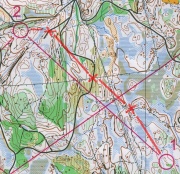From O-training.net
(Created page with '{{Orienteering exercises |Exercise Types=Attackpoints, Route planning |Description=Run a course with several long/half-long legs. Before leaving a control, have your attackpoints…')
Newer edit →
Revision as of 16:47, 1 April 2010
Orienteering Exercise: Leg splitting
Run a course with several long/half-long legs. Before leaving a control, have your attackpoints for the leg and your route for the leg ready. Method: For each leg, divide the leg into parts by identifying your attackpoints, i.e. the points on the leg which are your safe points where you need to be 100% sure about where you are. Mark these attackpoints mentally.
| Aim: | Get a good technique for mastering long legs by dividing it into shorter and easier segments. See how it is possible to simplify complex legs by splitting. Not splitting long legs into easier/shorter segments - and having full control at the attackpoints - is one of the main reasons for the really big mistakes which we want to avoid. |
|---|---|
| Variants: | One variant is to have the attackpoints drawn on the map and also marked in the forest. This can e.g. be done on the first 2-3 legs in a training to get the runners into the right habit. Another variant is to run two runners together, the first one being in control. The first runner tells the second runner about the attackpoints at the start of the leg, and then points at them and tells why this attackpoint is chosen when passing each attackpoint during the leg. |
| Aids: | None required. |
| Terrain: | |
| Preparations: | |
| Tips: | Use features which are easy to spot from as far away as possible and uniquely identifiable in this particular terrain-type as attackpoints. I.e. a small knoll is usually not a good attackpoint - a larger lonely boulder or a path crossing may be a good attackpoint.
Make an internal checklist with the attackpoints when leaving a control, and mentally tick of when passing each attackpoint. When leaving each attackpoint, check the compass carefully. If a you don't find a checkpoint, the alarm bell should ring, and you should get 100% confidence in your current position by tracing on the map where you have run since the last attackpoint. |
| Examples: |
Please Log in to contribute to O-training.net
O-training.net Blog articles:
- WOC Sprint Relay 2015: BIG GPS & Splits Analysis
- World Cup Long Spain: Quick GPS analysis
- WinSplits Pro for Iphone: Quick Review
- Gueorgiou: How to master the compass
- HeadCam analysis with local videos in 2DRerun
- What is effective technical training?
- RouteChoice Challenge: Long decisive leg in Swiss Champs Long
- WebRoute: Route choice leg Canada
- 2DRerun: Two very WOC Middle relevant races
- EOC Long Final: GPS Analysis
Useful links:
